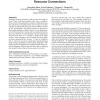Free Online Productivity Tools
i2Speak
i2Symbol
i2OCR
iTex2Img
iWeb2Print
iWeb2Shot
i2Type
iPdf2Split
iPdf2Merge
i2Bopomofo
i2Arabic
i2Style
i2Image
i2PDF
iLatex2Rtf
Sci2ools
IUI
2009
ACM
2009
ACM
Discovering frequent work procedures from resource connections
Intelligent desktop assistants could provide more help for users if they could learn models of the users’ workflows. However, discovering desktop workflows is difficult because they unfold over extended periods of time (days or weeks) and they are interleaved with many other workflows because of user multi-tasking. This paper describes an approach to discovering desktop workflows based on rich instrumentation of information flow actions such as copy/paste, SaveAs, file copy, attach file to email message, and save attachment. These actions allow us to construct a graph whose nodes are files, email messages, and web pages and whose edges are these information flow actions. A class of workflows that we call work procedures can be discovered by applying graph mining algorithms to find frequent subgraphs. This paper describes an algorithm for mining frequent closed connected subgraphs and then describes the results of applying this method to data collected from a group of rea...
Desktop Workflows | Information flow Actions | Intelligent Desktop Assistants | IUI 2009 | Software Engineering |
| Added | 19 May 2010 |
| Updated | 19 May 2010 |
| Type | Conference |
| Year | 2009 |
| Where | IUI |
| Authors | Jianqiang Shen, Erin Fitzhenry, Thomas G. Dietterich |
Comments (0)

